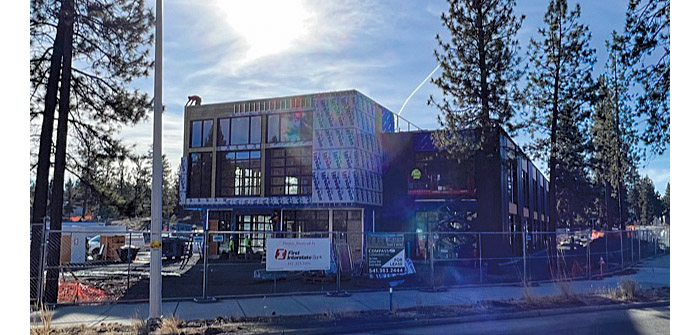(First Interstate Bank is financing this commercial building construction in Bend, located on W Newport Avenue | Photo courtesy of First Interstate Bank)
Commercial real estate markets in Central Oregon in 2023 will face unique difficulties and opportunities as they respond to local, regional, national and worldwide economic influences. The major influences on business in the region that use commercial real estate include changing labor trends, local livability issues and the availability and growing cost of resources.
Labor Trends
The national unemployment rate is reaching historic levels at 3.5%. Deschutes County is around 4% with Jefferson and Crook around 6% compared to a long-term average of over 7%. Sarah Lindsey, HR Consultant with Barrett Business Services Inc. says, “The demographics of our Central Oregon population has shifted. For example, many construction workers moved out of the area during the last recession and are not being replaced. Some of these industries offer lower-paying jobs and with the growing cost of living in the area, it can affect the supply of workers. The cost and availability of childcare is another factor that hinders potential workers from taking jobs in those industries.”
The low unemployment rate is a major challenge to businesses wanting to relocate to the area or planning to expand. Ben Haag, vice president and commercial group manager at First Interstate Bank, recently explained that “Availability of qualified employees is a major factor holding back commercial customers’ operations and growth in Central Oregon. If a business is able to hire, train and employ someone, it has to work hard to hang on to that person. In each business sector, competent employees are often lured away by other businesses.”
Opportunities exist for employers but they require creativity. One such opportunity is through EDCO’s Youth CareerConnect (YCC). It is a regional initiative that provides internship opportunities for high school and college-age students. Through these opportunities, local employers provide “real-world” work experience for students. YCC aims to achieve a “work-ready” labor force through successful placements of young adults in internships. Many are retained as long-term employees after their education is complete.
Local High Schools are also on board with preparing young people for careers. One such program is Redmond High School’s Career and Technical Education (CTE) program. Their program is preparing students of all ages to help drive business success and vitality in the areas of agriculture science and technology, automotive technology, business management, construction technology, manufacturing, natural resources, welding and more.
Most importantly, businesses must orient their thinking about being an employer of choice in their particular industry. Some of the defining characteristics of employers of choice are strong leadership, competitive pay, engaged workers, meaningful work and an attractive company culture. Lindsey says, “Those employers that focus on a positive employee experience and culture are going to be the ones winning the staffing war. When humans have a choice, they are going to choose the company with the best opportunities for growth, leadership that shows they value them, and yes it may come down to pay as well.”
Local Livability Issues
Regarding Central Oregon livability, Justin Taylor, commercial relationship manager at First Interstate Bank says, “The 800 lb. gorilla is Bend’s lack of affordable housing which affects labor supply in all areas of the local economy, be it trade, education, health care or professional services. However, this and the struggle with an unskilled labor force can be attenuated. We have strong representation in Oregon’s legislature to recognize and alleviate Central Oregon’s housing and labor force problems.” Cameronne Mosher, First Interstate Bank market president adds that “Urban Growth Boundary limits constrain the availability of land for Bend and other Central Oregon cities to accommodate the inflow of people and the increasing demand for commercial and business zoned areas.”
Availability and Growing Cost of Resources
Taylor commented about the impact on Central Oregon of an impending recession. He says, “Central Oregon this year is an economic growth area for First Interstate Bank. Our view is Central Oregon will not decline economically with a recession as much as other regional economies where the bank is located.”
To reinforce Taylor’s perception about the local economy, Steve Curley, executive director of Redmond Economic Development Inc. recently reported that the Milken Institute’s 2022 Report on Best Performing Cities charting resiliency and opportunity shows that Redmond is fifth in the Nation for employment growth, ranks third for five-year wage growth and ranks third for five year, high tech GDP growth.
Existing businesses in the region will be well advised to consider what could be more stress on already limited resources. Limited resources will include housing, existing labor pool and more commercial land and facilities. Rising costs of these resources will have an impact on product/service pricing and business expansion.
Lindsey commented on those realities. “We hear from our clients about shifting priorities to scale growth. That could mean not opening an additional location or not pursuing additional services or products. It also means that often business owners are working in the business themselves. If they don’t have enough staff for their restaurant, for example, they are cooking or serving customers themselves.”
Lindsey also offers sustainability advice for local businesses. She recommends, “Restaurants, for example, have already shifted to online ordering from smartphones at your table. It will be interesting to see how government and the business community solves these various challenges. Could strategic immigration provide additional workers in industries that need staff? The U.S. has a long history of filling positions with immigrants, and it’s still common for certain industries such as agriculture, construction and healthcare to run on labor from other countries.”





